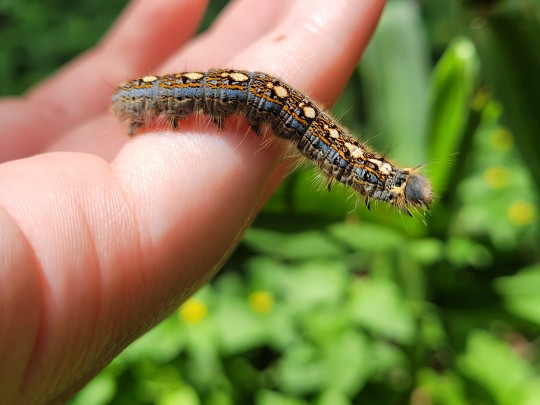#malacosoma americanum
Text

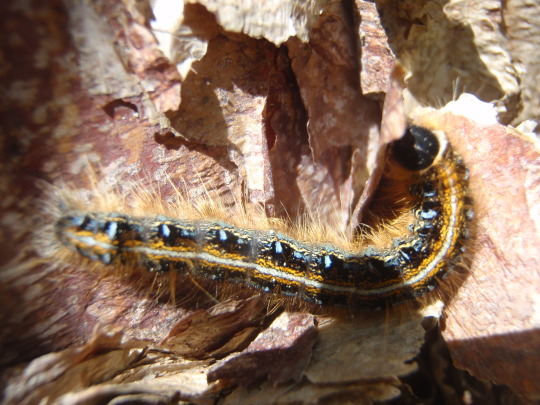

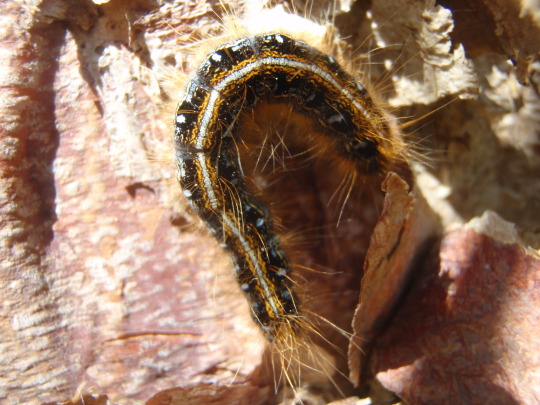

Malacosoma americanum (eastern tent caterpillar) i found this guy on a tree after not seeing any caterpillars this year :) i was so happy
photo by me
#Malacosoma americanum#eastern tent caterpillar#bugblr#bug#bugs#insect#insects#caterpillar#moth#larvae#me
3 notes
·
View notes
Text
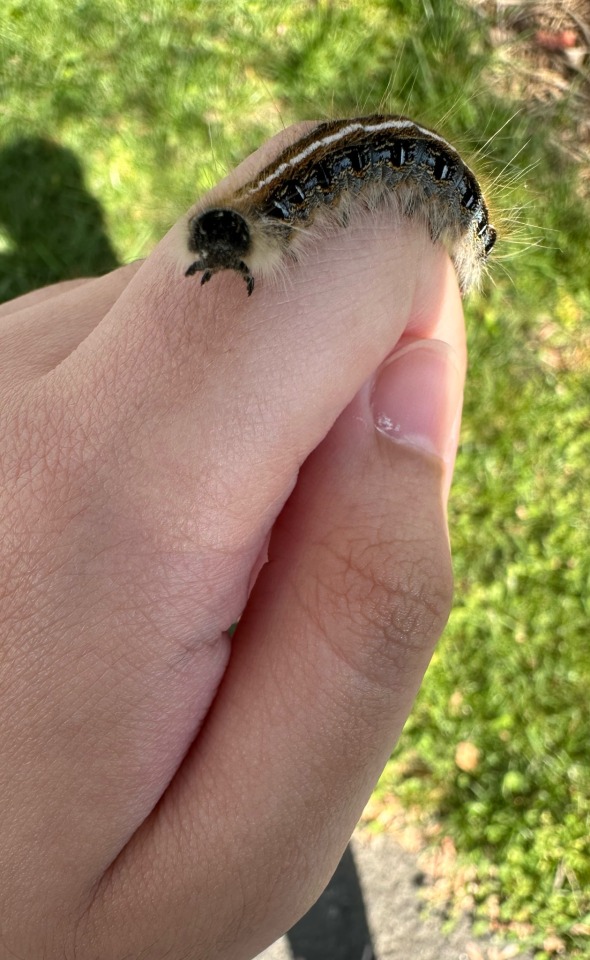
Tent caterpillar, oh how I love you tent caterpillar
#I loveee tent caterpillars so much they are so cute to me :3#lil fuzzy guys..#malacosoma americanum#< I think#caterpillar#🌸
0 notes
Text
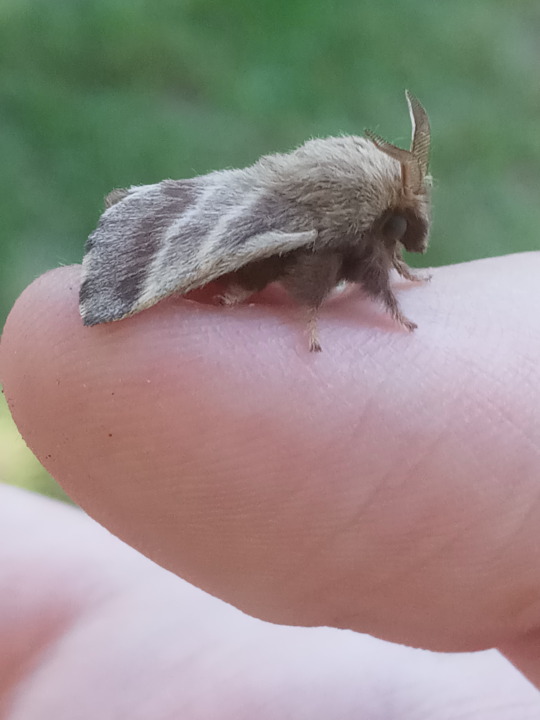

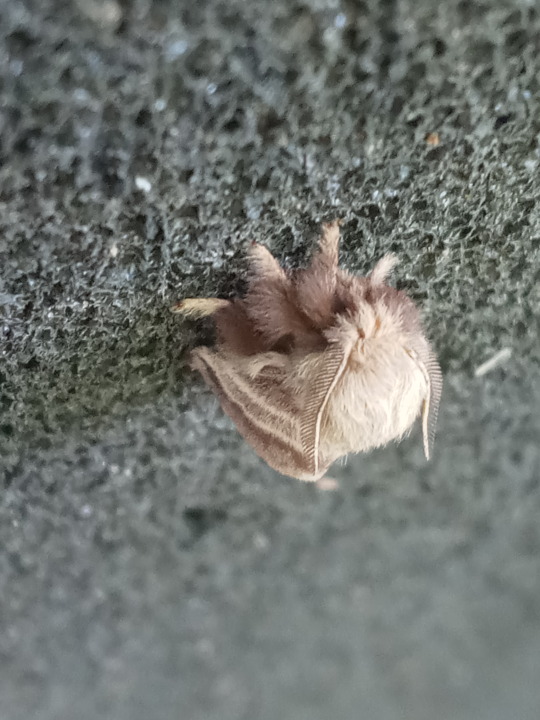
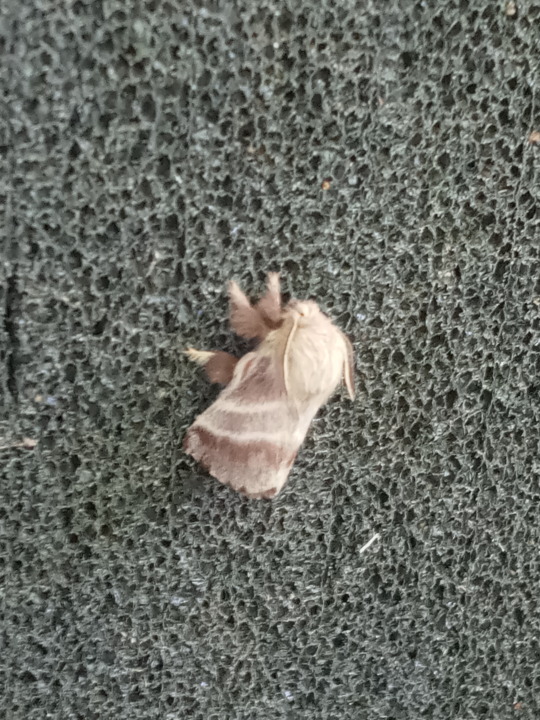
A fluffy little guy! (Likely Malacosoma americanum)
#Eastern tent caterpillar moth#Lappet moth#Lasiocampidae#Moth#Moths#Lepidoptera#Insects#Insect#Bugs#Photo#Photos#Wasp House Sights#Bug
248 notes
·
View notes
Text


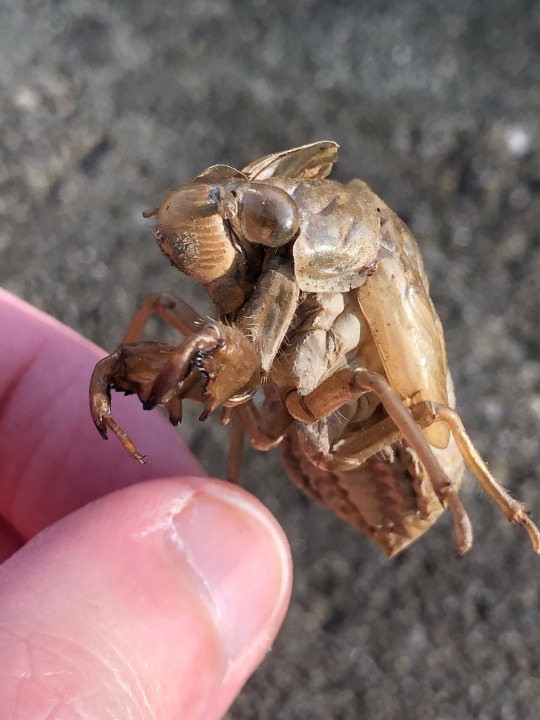

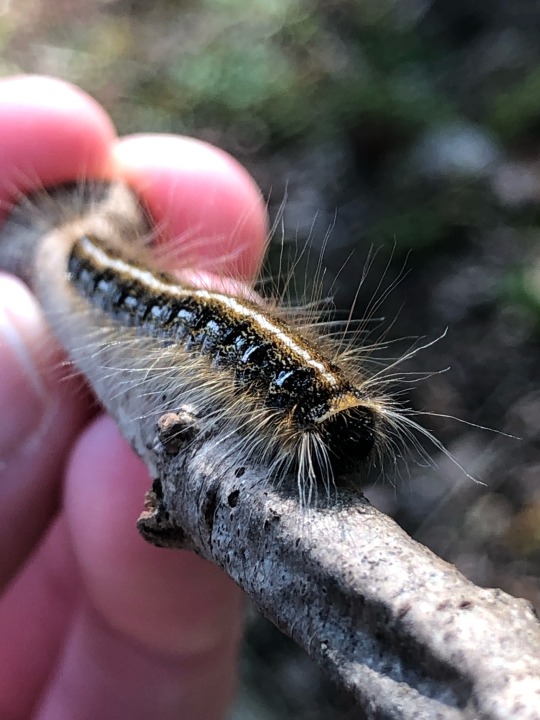


I don’t usually post personal wildlife photos, but it’s beginning to warm up and the little critters around here are coming out in full swing. I lived in a very dry climate at high altitude for a few years and almost forgot what it was like to live in a much warmer, more tropical place that houses a lot more animals. I can’t explain the joy I feel whenever I go outside and look for things! I’m going to try to identify each critter, left to right, top to bottom. If I’ve misidentified any of them, please let me know! I also apologize for the two photos taken behind dirty windows. If I’d known I was going to have guests, I would’ve wiped them down first.
1st pic: Eastern Wormsnake (Carphopis amoenus amoenus).
2nd pic: Metric Paper Wasp (Polistes metricus).
3rd pic: Cicada nymph shell, unsure of which species unfortunately, if at all that can be determined from shell alone.
4th pic: A young Long-Palped Ant Mimic Sac Spider maybe? (Castianeira longipalpa)
5th pic: Eastern Tent Caterpillar (Malacosoma americanum).
6th pic: Luna Moth (Actias luna).
7th pic: Pseudopolydesmus serratus. As far as I can find there is no common name for it!
#bugblr#wasps#snake#luna moth#caterpillar#millipede#cicada#spider#So glad that winter’s over.#corriethosaurus
17 notes
·
View notes
Text
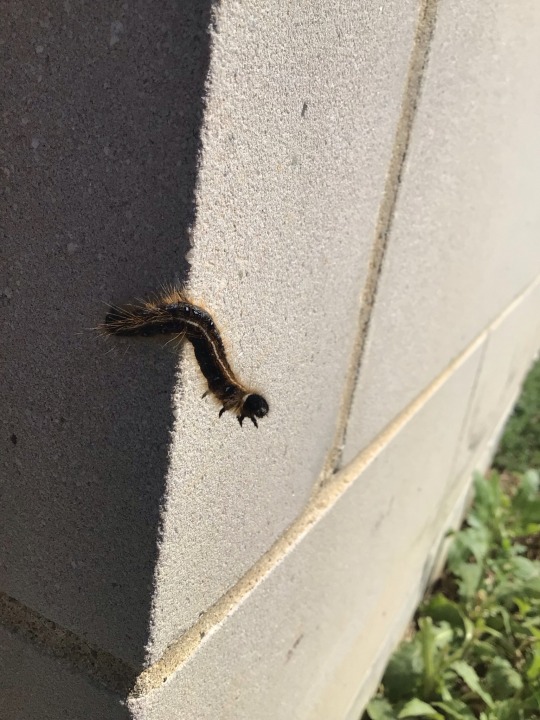
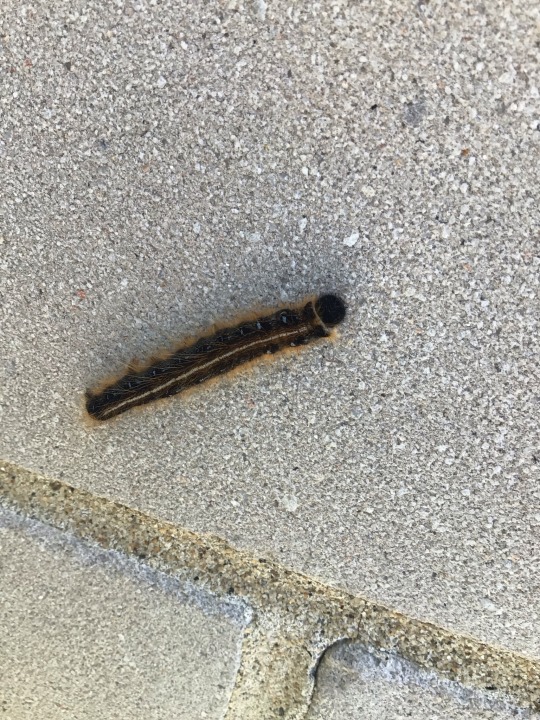
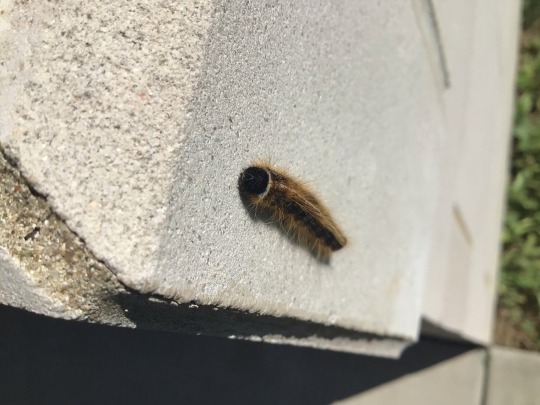
This beautiful little creature is the larval form of the malacosoma americanum, AKA the Eastern Tent Caterpillar!
It gets its name from its ability to create large tent webs, which groups of the caterpillars will use as a nest.
#caterpillar#moth#bugs#insects#nature#photography#entomology#tent caterpillar#I love this little fella
12 notes
·
View notes
Photo

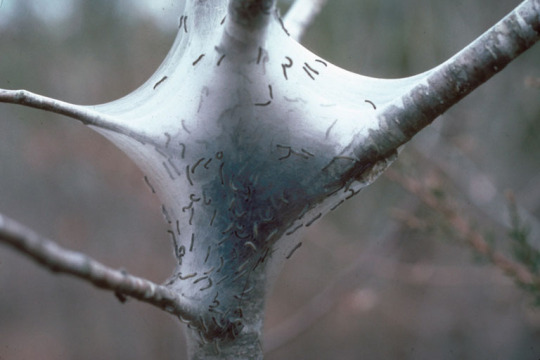

The eastern tent caterpillar (Malacosoma americanum) is native to North America. It constructs tents in many hardwood trees where branches fork. It is not harmful to the trees it feeds on, but some twig and foliage loss may occur.
4 notes
·
View notes
Photo

The eastern tent caterpillar (Malacosoma americanum) is a species of moth in the family Lasiocampidae, the tent caterpillars or lappet moths. It is univoltine, producing one generation per year. It is a tent caterpillar, a social species that forms communal nests in the branches of trees. It is sometimes confused with the gypsy moth and the fall webworm, and may be erroneously referred to as a bagworm, which is the common name applied to unrelated caterpillars. (at Arlington, Virginia) https://www.instagram.com/p/Cc0jOAOr6boyA27XLho2Q-8NKa1YnmpeZXfq_U0/?igshid=NGJjMDIxMWI=
3 notes
·
View notes
Text

This Eastern Tent Caterpillar (Malacosoma americanum) was one of the largest I've seen!
1 note
·
View note
Text
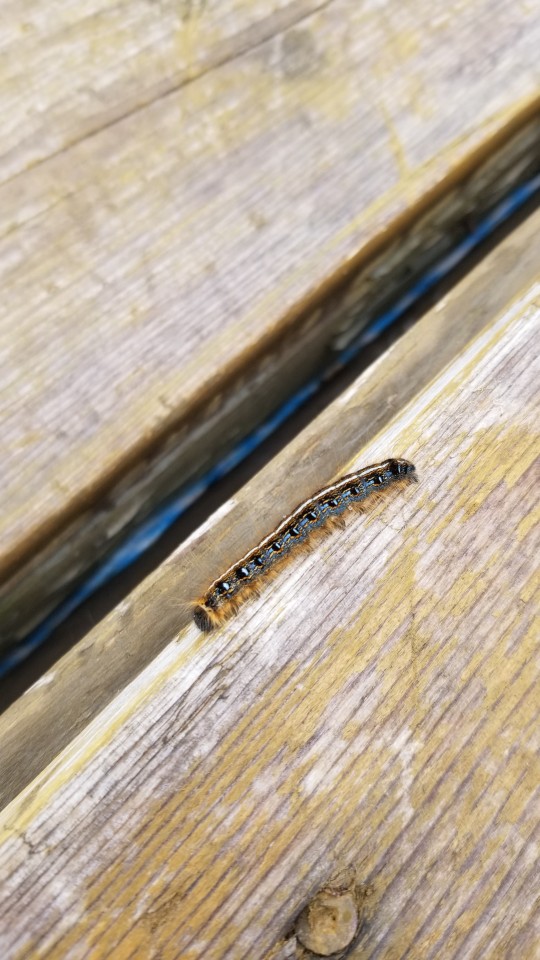
A beautiful Eastern tent caterpillar, Malacosoma americanum, spotted just outside on my deck.
1 note
·
View note
Text
Got to witness an Eastern Tent Caterpillar (Malacosoma americanum) make a cocoon today!!!!
There's a 3 min video on my TikTok (Safety_Snails) for anyone who wants to see!!
I sat there and watched him do his thing for two hours lol
#Malacosoma americanum#Eastern Tent Caterpillar#Eastern Tent Moth#entomology#caterpillar#cocoon#moth
4 notes
·
View notes
Text
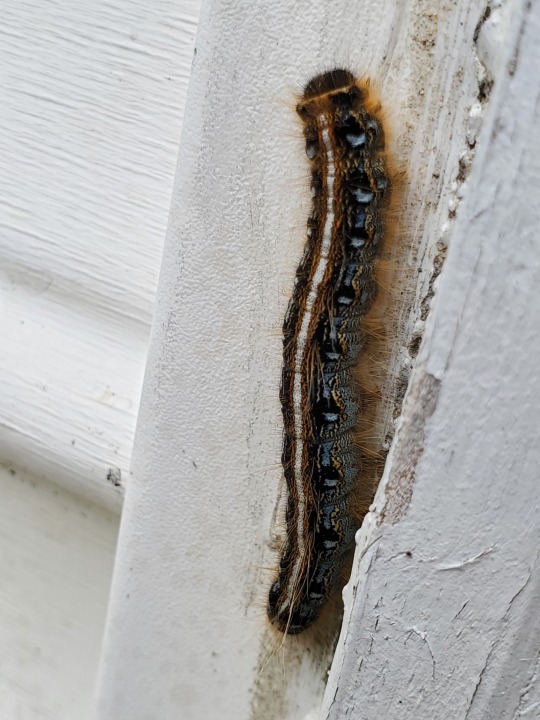
4/25/20
0 notes
Photo

These are a pest that are everywhere at this time of year. I usually ignore them, but this one decided to strike a pose for me.
Eastern tent caterpillar (Malacosoma americanum) on the edge of a hosta leaf.
May 11, 2017
Southeastern Pennsylvania
#Hosta#caterpillar#photographers on tumblr#Eastern tent caterpillar#Malacosoma americanum#lepidoptera
31 notes
·
View notes
Text
A cluster of Oriental Tent Caterpillars (Malacosoma americanum) reacting to the sound! 🔊🐛
Various species of social caterpillars can be quite sensitive to sounds, and although it sounds strange, this behavior is actually considered a type of defensive maneuver. When they hear loud sounds, the caterpillars go into a "war position", synchronizing their movements to look like a larger animal as a defense mechanism.
This phenomenon shows the awareness of unity and collective force that involves living beings and, in addition, the impressive capacity for synchronization built into the laws of nature.
❖ What are your thoughts on this?
▩ Tag your friends who would love to see this peculiar natural phenomenon!
📍 Location of the video: Amazon Forest in Alter do Chão, Pará, Brazil.
7 notes
·
View notes
Text
5 Garden Pests – Insect Identification & Treatment Tips
Prevent your garden from being devoured by uninvited pests. By knowing how to protect your garden from a variety of insects, you can grow your plants and crops stress-free.
gardeninginfo-online.com gathered the following information and tips to help you eliminate garden pests naturally, without using harsh chemicals.
Garden Pests – Identify and Combat These Insects
The following common garden pests, if left unchecked, can consume enough of your garden to leave your plants in poor health and your crops partially destroyed.
Slugs and Snails
Basically, slugs are snails without the shell. These gastropods eat large, ragged holes in the foliage of plants and can entirely consume seedlings. Slugs and snails pose a particular threat to:
Violets
Lilies
Cabbage
Lettuce
Strawberries
Spider Flowers (Cleome)
Floss Flower (Ageratum)
Hostas
The more problematic species of slugs and snails include:
Garden Snail (Helix aspersa)
Grey Garden Slug (Deroceras reticulatum)
Tawny Garden Slug/Cellar Slug (Limax flavus)
Leopard Slug (Limax maximus)
Slugs and snails travel over a trail of mucus, seek protection from dehydration in cool, shaded, and damp locations. Unless disturbed or treated, they will return to their hiding and feeding places nightly.
You can confirm the presence of snails and slugs in your garden by the dried mucus/slime trails they leave behind.
Control measures include:
Physical removal, when combined with other control measures, is an effective and long-lasting method of control.
Diatomaceous earth or “DE” sticks to the snail or slug’s body, causing desiccation. DE dust should be applied in inch-wide bands near and around your plants and garden. Reapplication may be necessary after heavy rain.
Copper strips fastened to flower bed containers or boxes are incredibly effective. Snails and slugs have a shock-like reaction when they are in contact with the metal.
Commercial traps, boards, tiles, shingles, or anything that offers daytime protection are very effective in trapping this pest.
Yeast trapping is another efficient method of control. Shallow containers filled with water and yeast or beer lure snails and slugs to the container only to fall into the liquid and drown.
While there are chemical control methods, it is highly recommended to seek natural, chemical-free solutions. If chemical control is used, pay particular attention to the label and its safety measures.
Caterpillars
Caterpillars are moths and butterflies in their larvae stage. These insects chew irregular holes in leaves or flowers and can entirely consume seedlings, young shoots, buds, leaves, or flowers.
A caterpillar’s diet is comprised almost exclusively of plants. Most caterpillars can be found consuming plant foliage, but some may feed on seeds, roots, stems, fruit, or flower petals.
Tip: Caterpillars can be identified by the three pairs of (true) legs behind the head and five or fewer pairs of leg-like appendages on some but not all abdomen segments. These features distinguish them from beetle, fly, and sawfly larvae.
Some of the more common, problematic species include:
Tent Caterpillar (Malacosoma americanum)
Evergreen Bagworm Caterpillar (Thyridopteryx ephemeraeformis)
Banded Woollybear Caterpillar (Pyrrharctia isabella)
American Lady Butterfly (Vanessa virginiensis)
Common Buckeye Butterfly (Junonia coenia)
Giant Leopard Moth Caterpillar (Hypercompe scribonia)
Bent-line Gray Caterpillar (Iridopsis larvaria)
Fruit Tree Leafroller Caterpillar (Archips argyrospila)
Cabbage Looper Caterpillar (Trichoplusia ni)
You can easily confirm the presence of caterpillars by examining the extensive damage to foliage, leading you to the insect’s presence. Caterpillars feed practically non-stop until they enter the pupa stage of their lifecycle.
Control measures include:
Pruning off rolled or webbed leaves and handpicking caterpillars from plants.
Applying bacillus thuringiensis-kurstaki (Btk) an organic microbial insecticide that kills only caterpillars. This product is safe to use around bees, beneficial insects, and wildlife. Newly hatched caterpillars must feed on treated leaves to be eliminated. Treatment timing is critical in early to mid-spring.
Covering your plants or crops with an insect barrier fabric (floating row cover). The covering forms a barrier, keeping moths and butterflies from laying eggs on the plants.
Neem oil can be sprayed directly on plants and foliage throughout late winter and spring to prevent egg laying and deter caterpillars from consuming the plant.
If commercial pesticides are used, pay close attention to the label and use only as directed. When treating edible plants, it is highly recommended to use organic alternatives.
Tip: When physically removing caterpillars from your garden, keep a container with a warm water and detergent solution handy. This solution kills caterpillars quickly.
Beetles
The beetle family (Coleoptera) consists of thousands of species, both destructive and beneficial, all necessary to maintain equilibrium in our environment. The following beetles are considered beneficial in a garden setting:
Tiger Beetles (Cicindelinae)
Soldier Beetles (Cantharidae)
Lady Beetles (Coccinellidae) also called ladybirds and ladybugs
Lady Beetle Larvae
These beetles spend their larval stage and adulthood consuming aphids, mealybugs, small invertebrates, and other insects. The following beetles devour plants, leaves, flowers, and can severely damage or kill trees:
Japanese Beetles (Popillia japonica)
Black Blister Beetles (Epicauta pensylvanica) Meloidae family
Red Milkweed Beetles (Tetraopes tetrophthalmus)
Cottonwood Borer (Plectrodera scalator)
Northeastern Sawyer Beetle (Monochamus notatus)
Rose Chafer (Macrodactylus subspinosus)
All beetles have a set of hard outer wing cases, known as elytra, and a hard upper body called a carapace. The elytra cover the flight wings and come together to form a straight line down the back. Beetles all have chewing mouthparts, powerful jaws, and antennae that are often longer than their boy length.
Damages may include boring holes in stalks and trunks, and partially or entirely consumed foliage, flowers, or fruit.
Control measures include:
Apply floating row covers
Prune and destroy (burn) affected stems and foliage
Handpick them and drown in a warm water, vinegar, and detergent solution
Spray foliage and stems with insecticidal soap or neem oil
Set out lures to draw soldier beetles (predators) to your yard and garden
Tip: You can attract soldier beetles by cultivating pollen-producing plants and allowing milkweed and wild lettuce weed species to grow.
Note: Using commercially produced chemical sprays or deterrents may cause severe damage to beneficial insects and the plant itself. It is highly recommended to use organic alternatives when treating consumable crops.
Aphids
Tiny aphids (Aphidoidea) congregate and quickly reproduce to form large groups that wound and suck juices from the host plant to the point of causing it to wilt, dehydrate, die. Without control measures, a small aphid issue can become an out-of-control infestation.
Aphids have long antennae and two tubes projecting from the rear of their abdomen. They are found in green, yellow, red, brown, or gray. They may be winged, depending on the species and life stage.
They usually congregate on fruits and vegetables, flowers, ornamentals, and even shade trees throughout the North American continent. Aphids feeding on plant sap cause foliage to distort and drop. Honeydew excreted on leaves promotes sooty mold growth, and their feeding can spread viral plant diseases.
The honeydew produced by aphids not only causes the growth of sooty mold, but it also attracts other insects, including ants, that compound the pest problem.
Control measures include:
In infested areas, frequently wash sturdy plants with a strong spray of water
Attract native predators and parasites such as aphid midges, lacewings, and lady beetles
Cover plants with floating row covers
Apply hot-pepper, garlic repellent sprays
When infestations become severe problems, apply horticultural oil, insecticidal soap, or neem oil
Note: Aphid infestations are typically accompanied by an ant infestation. Ants “herd” the aphids and farm the honeydew to nourish their colony. Once you control the aphid infestation, direct your attention to controlling the ants.
Ants
Individual ants are members of highly organized colonies. They are always in search of nourishment and water to promote the health and growth of their colony.
Once a source of nourishment is located, ants will return to their colony via a pheromone trail, which is the path for the rest of the colony to follow. As long as the pheromone trail exists, ants will follow it regardless of your control measures.
Ant colonies can consume incredible amounts of plant foliage, but, as previously mentioned, they can also “herd” aphids to collect the honeydew they produce after consuming the juices from your plants.
Some of the more destructive ant species are:
Black Garden Ant (Lasius niger)
Black Carpenter Ant (Camponotus pennsylvanicus)
Fire Ants (Solenopsis invicta) also known as Red Imported Fire Ant (RIFA)
Wood Ants, Mound Ants, Thatching Ants, and Field Ants are all part of the genus Formica
Leafcutter Ants are part of nearly fifty species belonging to the Atta and Acromyrmex genera
Control measures include:
Squeeze a lemon or an orange over areas where the ants transit
Sprinkle pepper, salt, cayenne pepper, or cinnamon around areas you wish to protect
Peppermint or white vinegar can be spread around to repel them
Spray ants with a mixture of water and dish soap (the soap penetrates their exoskeleton and kills them)
Lay a one-inch strip of food-grade diatomaceous earth by trails and nests
Set borax (or boric acid) and sugar poison traps around your plants
Set traps with powdered sugar and baking soda (the baking soda dries their bodies and kills them)
Eliminate aphids from your garden
Tip: Wherever you see an ant trail, make it your goal to interrupt the pheromone trail they are leaving behind. You can accomplish this with diluted white vinegar or juice squeezed from a lemon or an orange.
Note: When you apply salt to soil, you are altering the soil’s pH and potentially harming the plants growing there.
Read the following link for additional tips and advice on keeping pests out your garden, and check out this simple recipe for homemade non-toxic pesticides for your garden.
Garden Pest Control
In this article, you discovered information on how to identify and eliminate 5 destructive garden pests without using harsh chemicals.
When you take action to control and eliminate garden pests, you can preserve your garden and crops, harvesting pristine fruits and vegetables.
Allowing garden pests to flourish can lead to massive infestations leaving your garden looking chewed up and dying.
Sources:
extension.umd.edu/hgic/topics/slugs-and-snails-flowers
wildlifetrusts.org/wildlife/how-identify/identify-caterpillars
insectidentification.org/insect-description.asp?identification=Aphids
extension.umn.edu/insects-infest-homes/ants
caterpillaridentification.org/
ipm.ucanr.edu/QT/lfcaterpillarscard.html
The post 5 Garden Pests – Insect Identification & Treatment Tips appeared first on http://gardeninginfo-online.com.
1 note
·
View note
Photo
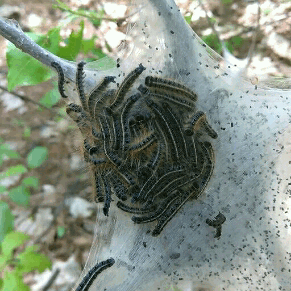
Eastern Tent Caterpillars. Malacosoma Americanum.
-C.G
#gif#malacosoma americanum#eastern tent caterpillar#caterpillar#entomology#photography#insects#original content#apegarden#lasiocampidae
0 notes
